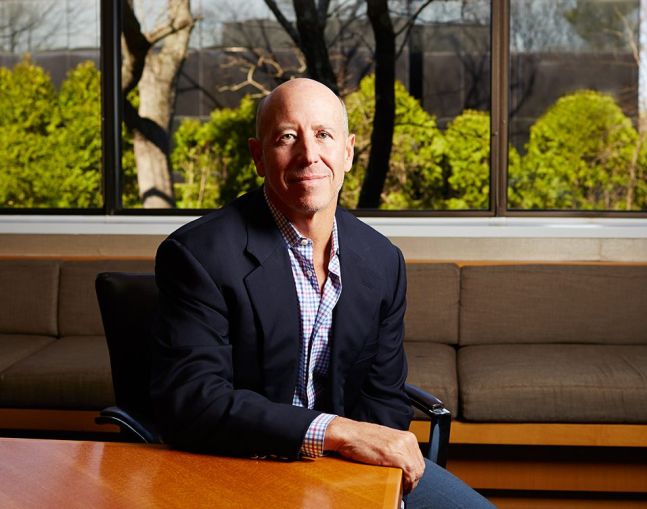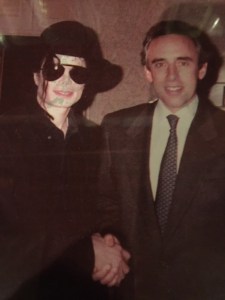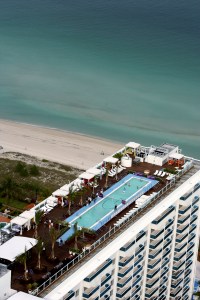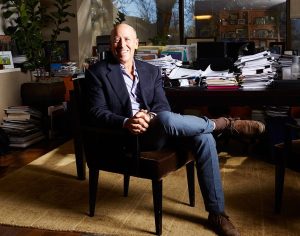What Makes Starwood’s Barry Sternlicht Tick?

In the late 1990s, shortly after Barry Sternlicht, the head of Starwood (STWD) Lodging Trust (and Starwood Capital Group), went through a dramatic and highly public purchase of ITT Corporation (the conglomerate perhaps best known for Sheraton Hotels), he decided he didn’t want to keep one of the assets: Caesars Palace in Las Vegas.
“Caesars at the time had a big baccarat business—which is very volatile,” said Thomas Flexner, a vice chairman and the global head of real estate at Citigroup, who was working at Bear Stearns, Starwood’s banker at the time. In baccarat, big sums of cash go in and out of the casino quickly. Mr. Sternlicht “didn’t think that type of business should be in a public company.”
Although he was still in his 30s (he’s now 55), Mr. Sternlicht had done deals with many of the wealthiest and most successful figures in real estate from Sam Zell of Equity Group Investments to the Ziff and Burden families. It wouldn’t have been tough to find a high-wattage name to sell it to. But one of the people who approached Starwood about buying Caesars had wow potential: the king of pop, Michael Jackson.
Messrs. Sternlicht and Flexner went to Jackson’s suite at the Waldorf-Astoria to meet the music deity.
Jackson was wearing a single black glove. He had a staff photographer on call, under the assumption that anyone who met with Jackson would want to have a picture taken with him. (Both of Jackson’s guests did, naturally.)
“He was explaining how he was the inspiration for Treasure Island [in Las Vegas] and could do wonders with Caesars,” Mr. Sternlicht said.
The meeting lasted an hour and a half. Messrs. Sternlicht and Flexner came away dazed and thinking Jackson was a sweet, likable person, if not the greatest businessman they had ever met. (Mr. Sternlicht lost his photo of himself with Jackson—however, Mr. Flexner still has his.)
“I don’t think it was a very sophisticated effort,” Mr. Flexner said. “But, hey, when Michael Jackson calls, you take the meeting.”

Incidentally, a lot of people say the same thing about Barry Sternlicht. (Not the unsophisticated part.)
Mr. Sternlicht is not merely the custodian of a $77 billion real estate, hotel and debt empire—he is a creative force. The chairman and chief executive officer of Starwood Capital Group doesn’t just buy a St. Regis—he replicates it around the world. When he came up with a new boutique hotel brand, it is not just a Sheraton with a fancy lobby—it is the W Hotels. And he has acquired a reputation through the business world that draws a lot of varied figures to him.
One person who took a meeting with Mr. Sternlicht was Rusty Gregory, the chairman and Chief Executive Officer of Mammoth Resorts, who went out to Aspen, Colo., to rendezvous with him in 2005 at Teddy Forstmann’s yearly retreat.
Mr. Gregory was in the process of selling his ski resort and the accompanying real estate, all at Mammoth Mountain, in the Sierra Nevada mountains in California, and had been fairly far down the road with a bidder when Mr. Sternlicht’s Starwood had come in with an offer. (The eventual sale would be for $365 million.)
“I had heard what a smart guy, what a tough guy, Barry was from a business standpoint,” Mr. Gregory said. “[He] could be tough on his company—but was the smartest guy in the room. He had that kind of reputation.” Still, the offer was a good one, and Mr. Gregory figured this would be his final audition for the new owner.
The two men went for breakfast at the Little Nell—with Martha Stewart in sweats two tables down—and did not get up for three hours.
The brash business mogul was nowhere in sight. Instead, Mr. Sternlicht spoke about life and family. “He talked about his mother and father—very personal things,” Mr. Gregory said. “I was very impressed with him. He had a compelling personality.”
When they finally got around to discussing Mammoth, Mr. Sternlicht did something one didn’t normally see out of a guy whose living was built on numbers: He started drawing.
“He pulled out this pad, and he drew the core business of Mammoth, which was a ski mountain,” Mr. Gregory said. “And then he put hotels on the base with notations—the number of hotel rooms. Then there were the associated amenities, the spa, the restaurant.” All this wound up on the pad. Finally, when they spoke about transportation to Mammoth, he drew an airplane at the top of the page.
“I’ve been in business a long time—I’ve never seen anyone express it like this. In a very organic way. More like a designer would do it.” But he had also managed to summon up Mammoth’s business and mission at the same time.
“Unlike the majority of superstar investors, he has a fully functional right brain as well as a left brain,” Mr. Flexner explained.
*
“I actually think the U.S. economy is doing fairly well, given the headwinds it’s looking at,” Mr. Sternlicht told Commercial Observer from his office in Greenwich, Conn., speaking fluently from the left brain. “In this climate, where institutions and corporations and CEOs don’t know what they should invest in, or where, I would have expected that you’d have some kind of weak economy—weaker than this.” As for real estate, “it’s really as good as it’s been since ’91 in the States…The housing market’s on fire. Everyone talks about this sad market—it’s probably the best performing asset class in the country.”
Starwood has been putting fairly significant bets on this point of view; it picked up 23,262 residential units from Equity Residential (EQR) last October in a $5.4 billion deal, and another 19,615 units from Landmark Apartment Trust in a $1.9 billion acquisition, bringing its residential portfolio to approximately 90,000 units. But the interesting thing is the geography of these purchases; they’re in the middle of the country where housing is still cheap and where job growth is on the rise.
“We stayed out of what we used to buy, which are the two coasts—certainly New York and San Francisco,” Mr. Sternlicht said.
Why?
“We thought they’re unaffordable,” Mr. Sternlicht responded, simply. “We’re really worried about the tech bubble, so we’re really worried about the Bay Area.”
When CO visited Mr. Sternlicht, the tokens of his success and his work ethic were visible. Starwood’s office building is a well-curated piece of real estate just over the New York border with a luxe gym on the ground floor and showers in the men’s rooms. Handsome pieces of art line the walls. A sea of glass awards and plaques are swept over one of the tables outside of Mr. Sternlicht’s office and his desk is overflowing with business and design plans. Photographs along the perimeter of his office show Mr. Sternlicht rubbing elbows with boldfaced names. (CO spotted two photos of Mr. Sternlicht with GOP frontrunner Donald Trump, one that also included Stephen Schwarzman and Michael Milken in the frame. But in the interest of equal time, it should be noted that Mr. Sternlicht has also played golf with the husband of the Democratic frontrunner.)
And the left, right brain dynamic, with all its inherent contradictions, was on display, too, in an hour-long conversation with CO.
“I’m an artist by nature—I love to paint and draw and sculpt,” he said. “Last count, I think I was one of two businessmen inducted into the Interior Design Hall of Fame. I’ve won a lot of awards, but that one’s my favorite one.”
He’s as contemptuous of the left wing politics in a country like France as any private equity guy. (When speaking about a deal in France he called it, “The world’s hardest market to invest in.” Why? “They’re communist,” he answered.)
But his 1 Hotels are the most ambitiously green in the world.
“They say it’s not a brand—it’s a cause,” Mr. Sternlicht said, regarding 1 Hotel, the eco-luxe boutique hotel that opened last year in Manhattan at 1414 Avenue of the Americas at the corner of West 58th Street and is gearing up to open another at Brooklyn Bridge Park along the waterfront later this year and bills itself as 100 percent sustainable. It is his favorite child amongst his business ventures. (He has three real children—a Dartmouth alum, a Brown student and a Stanford student. His children are the inspiration for the 1 Hotels brand.)
He paused and collected his thoughts.
“I do think we’re screwing up the earth—despite what my Republican friends say,” Mr. Sternlicht said. “I’m fiscally Republican. [But] I think we’re responsible for maintaining the planet, and I just don’t see any downside to doing so. If we’re wrong, and it’s not global warming, then fine. If we’re right, then we have to do this.”
The left, right brain mastery was particularly well suited to a career in hotel development. When he founded Starwood in the early 1990s, he was a shrewd enough businessman to take advantage of a little-known (and now defunct) federal law called the “paired share” real estate investment trust that allowed Starwood to own properties and management companies at the same time. This gave Starwood a notable tax advantage in that, like a REIT, it doesn’t pay taxes on its earnings, but it could manage its own properties so it didn’t have to lease out the hotels and thus pay exorbitant management fees to an independent operator.

But his sense of style and vision remained ever present. “When we were developing [1 Hotel South Beach which opened last year]—and it was a $650 million project, it was difficult to do—every plant, every tree, every blade of grass met with his scrutiny,” said Richard LeFrak, the chairman and CEO of LeFrak, who has done a number of deals with Mr. Sternlicht, including the $2.7 billion dollar acquisition of the failed commercial real estate lender Corus Bank’s CRE portfolio in 2009. “We would go into the building, and I wanted to talk about the elevators—he wanted to talk about the palm trees. But he’s a very visual person. That’s what jumps out at him.”
His career in real estate began largely with his father—who, one gets a sense very quickly, left the greatest mark on Mr. Sternlicht’s life.
When he was a young Brown University graduate trying to finagle his way into a Wall Street career, Mr. Sternlicht’s father posed one of the more indelible of life’s questions before him:
“Do you want to look at a green screen for the rest of your life?”
Maurycy Sternlicht fled Cracow as a 9-year-old to what is now the Czech Republic where he hid out with Czech partisans throughout World War II. In an obituary the family published after his death, the senior Sternlicht’s life during the war years was described as one lived in caves scrounging for food.
“He never talked about the war,” Mr. Sternlicht said. After the war, his father got an engineering degree from the University of Brussels, immigrated to the Bronx in 1951 and changed his name to Mark. Still, the weight of a life that took root during the Holocaust clearly did something to both the man and his son—as did Mark Sternlicht’s subsequent history in America.
“My dad’s business went bust,” Mr. Sternlicht said. “He was on the Chamber of Commerce here in Connecticut—he was the quintessential successful small businessman. And one day he turned around and his inventory had been stolen.” The company, which manufactured disposable flashlights, was later liquidated.
“[Barry] went to great lengths to say what kind of man that made him,” Mr. Gregory said. “He has great respect for his father—about how he handled adversity. Tremendous respect for him. But he was also this boiling cauldron of determination that this would never happen to him.”
That determination drove Mr. Sternlicht to business school at Harvard and then to Chicago in the mid-1980s where he spent several years in the real estate trenches for JMB Realty before getting a pink slip in the wake of the savings and loan crisis in the early 1990s.
He decided to start his own platform with backing from his old boss at JMB, Neil Bluhm, the Burden family and the Ziff family.
“That became Starwood Capital Group, which we named for a housing development in Aspen—which is still there,” Mr. Sternlicht said. “It was named by Dirk Ziff in his hot tub with me when I was 30.”
*
“In 1998 I went a little haywire.”
Mr. Sternlicht had started the decade picking up apartment buildings (and doing quite well at it; he bought 8,000 units in 18 months and sold them to Sam Zell of Equity Group Investments, tripling his money), but over the course of the 1990s he migrated into different asset classes starting Starwood Lodging in 1994.
However, by 1997, he saw an opportunity to pick up the hotel company, Westin, which he took. After that colossal $1.5 billion acquisition, an even bigger prize lay in sight.
ITT, the company that owned Sheraton, was being eyed for a hostile takeover by Hilton Hotels. Hilton was attempting to force ITT’s board to meet to appoint a new slate of pro-Hilton board members. (A verbal battle also ensued in the press in which Hilton’s head, Stephen Bollenbach, publicly called the head of ITT, Rand Araskog, a “weenie” and then a “superweenie.”)
“One day I woke up in the morning, I opened The Wall Street Journal, and I see that Hilton won the court case—ITT lost the ability to prevent a board meeting,” Mr. Flexner said. “I called up Barry and said, ‘Araskog is going to want a white knight.’ ”
According to a story in National Real Estate Investor, Mr. Sternlicht had beaten Mr. Flexner to the punch—he had been faxing over proposals to ITT that morning.
Starwood Hotels went into marathon round-the-clock negotiations, and in two weeks they came up with an agreement. (Mr. Flexner told National Real Estate Investor at the end of negotiations his team looked like they had “stepped out of the jungle after the Tet offensive.”)
After the agreement was announced, “it started this major PR bidding war,” Mr. Flexner told CO. “Full-page ads were taken out in the Journal. But Starwood was able to prevail.”
It was, in Mr. Sternlicht’s words, “a minnow-swallows-the-whale deal.” By the time Starwood made the offer, “we were roughly a $7 billion company buying a $14 billion company.” (The deal was paid for largely in stock.)
“So, Sheraton was based in New York; Westin was in Seattle; and Starwood Lodging was mostly in Phoenix—and they merged everybody to White Plains here,” Mr. Sternlicht said. “I had three of everything. Three CFOs. Three HR directors. I didn’t know what I was doing—but we had $9 billion of debt, so I had to learn fast.”
Some of this involved selling off the unwanted assets like Caesars.
Aside from Jackson, Steve Wynn had wanted to purchase Caesars and made a $2.8 billion offer, which Mr. Sternlicht initially accepted. But the late-Arthur M. Goldberg’s Park Place Entertainment came in with a better one.
An infuriated Mr. Wynn demanded an audience with Mr. Sternlicht after he had heard that his offer had been passed over for Goldberg’s. “Steve was sitting in his office, with two German shepherds at his side… [He was] the color of a tomato he was so angry at me,” Mr. Sternlicht said. Former professional poker player, Bobby Baldwin, who was chief financial officer of Mr. Wynn’s Mirage Resorts, came into the room and whispered something into Mr. Wynn’s ear. Suddenly, Mr. Wynn decided to quietly back down. (Apparently Mirage forgot to factor in the corporate overhead when it made its $2.8 billion offer.)

Yvonne Albinowski/For Commercial Observer
As Mr. Sternlicht’s plane was about to take off from Las Vegas, one of Mr. Wynn’s lawyers was, according to Mr. Sternlicht, running down the runway, chasing down the plane to get a final signature from Mr. Sternlicht on the documents dissolving the initial agreement.
But the other part of the ITT purchase was opening up a great collection of hotels and taking it for a spin.
Mr. Sternlicht took one of the most luxurious properties in the portfolio, the St. Regis in New York City and asked why it had to be a standalone property? Why not create a whole chain of luxury hotels under the St. Regis label? So that is exactly what he did, replicating another St. Regis in San Francisco before moving on to other cities.
This began a particularly creative and expansive period; Mr. Sternlicht took the Doral Inn at 541 Lexington Avenue between East 49th and East 50th Streets and turned it into a boutique hotel geared toward a younger crowd—this was the first W Hotel.
All the while, he was still managing Starwood Capital, and in 2005, Mr. Sternlicht attempted to semi-withdraw from Starwood Hotels and act as a consultant and chairman of the board. He hired Steven Heyer to be CEO, but as Mr. Heyer attempted to make changes at the company, a public duel between Messrs. Sternlicht and Heyer played out. (Mr. Heyer was eventually forced out in 2007 because of what was described in the Journal as “personal misconduct.”)
Indeed, Mr. Sternlicht’s reputation for perfectionism (the “blade of grass” stuff Mr. LeFrak spoke about) oftentimes was translated in the press as “control freak.”
“In the hotel industry, he’s embarrassed a lot of people,” Ted Darnall, the former head of Starwood’s North American operations, told Portfolio magazine in 2007 regarding Mr. Sternlicht. “He had the vision and strategy that the so-called experts didn’t see or said wouldn’t work… That’s going to result in a lot of people wanting to see him fail.”
The way that Mr. Sternlicht has handled his public image is, in his own view, one of his failings.
“I was naïve,” Mr. Sternlicht told CO. “I thought you just post numbers, and that’s enough. But you have to manage your image almost as if it’s a person apart from you. Perception can be reality. I didn’t know that—I learned that later in my career.”
Even after exiting Starwood Hotels, Mr. Sternlicht was active in the hotel business. He kept pursuing projects, like the one at Mammoth Mountain. But he would be most tested, like everybody else in the business world, during the economic meltdown of 2008, and it’s where his status in the real estate world took on an even greater depth.
“It was clear that the world was ending,” Mr. Sternlicht said. “I was really worried about our pension capital…so I came up with the idea of raising a blind pool on the New York Stock Exchange.” The idea was to make real estate loans when nobody else would. A number of banks turned Mr. Sternlicht away until Deutsche Bank agreed to work with him on the initial public offering.
The thinking from his investors was, “If I could build a hotel company, I could build a mortgage company,” Mr. Sternlicht said. “A lot of old shareholders came into the deal. Maybe it was just a bet on us.”
Mr. Sternlicht hoped to raise $500 million but wound up raising $900 million.
“We could have raised over $1 billion,” Mr. Sternlicht said. “But the banks were reluctant to re-sticker and refile…Until November or December of that year, it was the largest [initial public offering] in the United States that year. And it was the largest blind pool ever raised on the New York Stock Exchange. And it was the third-largest REIT IPO in history.”
This company became Starwood Property Trust, the largest commercial mortgage REIT in the United States, which today owns the world’s largest commercial mortgage special servicer, LNR Partners.
If anything, pressure brings out Mr. Sternlicht’s best self.
“It’s actually easier when there’s a crisis, or when you’re not doing well than when you’re doing well,” Mr. Sternlicht said. “I think it’s human nature. Sometimes the worst comes out when you’re super-successful. Now you’re fighting about the pie—before there was no pie to fight about.”
For example, Starwood had bought Mammoth at the worst possible time in 2005. “We had a major drought [that year],” Mr. Gregory said. “The next year we had a major drought—but not as bad. The next year we had a global financial meltdown.”
The setbacks didn’t scare Mr. Sternlicht. In the darkest days of the recession, the discussions between Messrs. Gregory and Sternlicht were about positioning themselves for better times and not diluting their brand. Even after the economy seemed to be coming back, the droughts in California kept coming. At the most severe of the drought, in 2014, Mr. Gregory came to Mr. Sternlicht with what he called “a wingnut idea”—namely, to buy another California ski resort at Big Bear. (Nobody else at Mr. Gregory’s company thought this was a smart move.)
“Why on earth would you think of doubling down?” Mr. Sternlicht asked.
“Because it’s the opposite of what everybody else would do,” was the reply.
“That’s exactly right!” Mr. Sternlicht exclaimed.
Big Bear, a resort just an hour away from Los Angeles, proved to be a shrewd investment. “In the last year,” Mr. Gregory said, “we did $22 million [earnings before depreciation and amortization]—they were doing $2.5 million EBDA when we bought it.”
“The combined complex will make $75 million this year,” Mr. Sternlicht said. “Our investors should make an incremental $200 million because we held on…I’m really proud of us, proud of the management at Mammoth for executing their strategy so brilliantly.”
Mr. Sternlicht looks more animated than at any other point during the interview.
“It’s my dad originally telling me, ‘Do you want to look at a little, bitty screen for the rest of your life or look in the mirror and feel good about what you do every day?’” Mr. Sternlicht said. “I look in the mirror and feel really good about what we’ve done for the past 26 years.”


